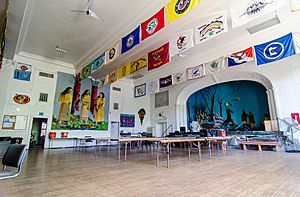American Indian Center facts for kids
| Founded | September 7, 1953 |
|---|---|
| Type | Non-profit cultural organization |
| Purpose | To promote fellowship, understanding, and to perpetuate cultural values |
| Location | |
|
Area served
|
Chicago metropolitan area |
| Services | Archery, Social services, education, cultural programming |
|
Key people
|
AL Eastman, Archery Director |
The American Indian Center (AIC) in Chicago is the oldest center for Native American people in a city. It helps Native Americans by offering social services, programs for kids and seniors, and chances to learn about their culture. It also provides places for people to meet. For many years, the AIC was in the Uptown area. Now, it is located in the Albany Park, Chicago neighborhood.
Contents
Why the Center Was Needed
The number of Native American people living in Chicago grew a lot in the 1900s. This happened because the U.S. government had policies that encouraged Native Americans to move from their reservations to cities. People also moved to find jobs and better opportunities.
Before the AIC, groups like the First Daughters of America helped Native Americans in Chicago. This group was started in 1930 by Tsianina Blackstone, an opera singer, and other Native American women. They wanted to make sure Native Americans were shown fairly in books and movies. They also worked to keep traditional Native American arts, crafts, and music alive. These groups provided important support until centers like the AIC were created.
History of the American Indian Center
The American Indian Center was started in 1953. It was created to help the many Native American people moving to Chicago. These people came from tribes all over the country. They needed a place to connect and build a new community in the city.
Native Americans from many different tribes helped start the Center. They also got help from the Quaker-affiliated American Friends Service Committee. From the very beginning, Native American members from various tribes have guided the Center. They make up its board of directors.
One of the AIC's longest-running programs is its yearly pow-wow. A pow-wow is a gathering where Native Americans celebrate their culture through dancing, singing, and socializing. The Center has also worked with schools, like Chicago Public Schools. They helped create special education programs for Native American students. For example, Little Big Horn High School was started in 1971.
The AIC opened its current center in Chicago in 1966. In 2005, it also opened the Trickster Gallery in Schaumburg, Illinois. This gallery showed art by modern Native American artists. The Trickster Gallery is no longer connected to the AIC. The American Indian Center is part of the Chicago Cultural Alliance.
The AIC also has an archery program. This program helps young people and adults learn archery skills. It includes Junior Olympic and Adult Achievement programs.
Other Important Groups
The American Indian Center played a role in starting other important Native American groups in Chicago. One of these was the Native American Committee (NAC). This group began in 1969. It supported a protest called the Occupation of Alcatraz.
In 1971, the director of the AIC passed away. This led to some changes and disagreements about the Center's future. A group of young leaders from the AIC wanted to use stronger ways to fight for Native American rights. They left the AIC and helped form the NAC. Many of these leaders had been part of the AIC's youth programs. The NAC was very important in starting the Native American Educational Services College in 1974. This college was run by and for Native Americans until 2005.
The AIC also supported a protest for better housing for Native Americans in Chicago. In 1970, a woman named Carol Warrington and her children were forced to leave their apartment. This was because she protested the poor living conditions. Protesters used a ceremonial teepee from the AIC. This teepee became a symbol for a protest camp. The camp demanded better housing for Native Americans in the city. However, some members of the Center thought the protest should be short and did not continue to participate.
See also
- Urban Indian


